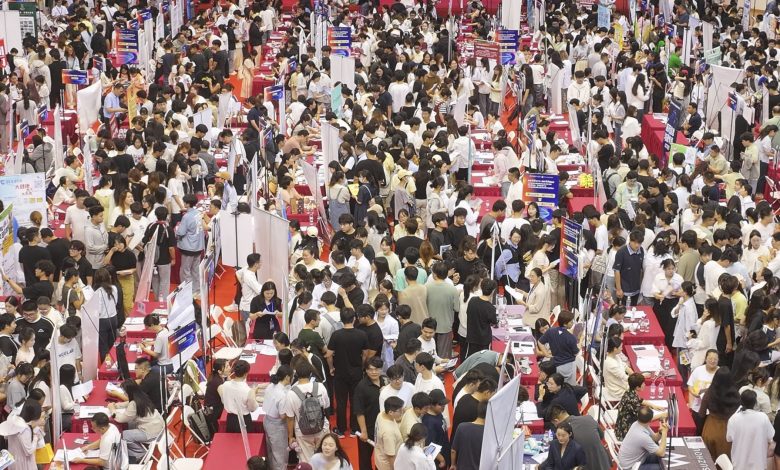AI hits an already weak jobs market

College graduates of the class of 2025 seek jobs at a special job fair for the new food and biomedicine industries in Huai ‘an City, Jiangsu Province, China, on June 8, 2025.
Nurphoto | Nurphoto | Getty Images
This report is from this week’s CNBC’s The China Connection newsletter, which brings you insights and analysis on what’s driving the world’s second-largest economy. Each week, we’ll explore the biggest business stories in China, give a lowdown on market moves and help you set up for the week ahead. Like what you see? You can subscribe here.
The big story
China’s eagerness to adopt artificial intelligence comes just as economic growth is slowing, putting millions of routine jobs at risk.
“I’m planning to get rid of 360 [Security Technology’s] entire marketing department. This way the company can save tens of millions a year,” founder and chair Zhou Hongyi said in a Chinese-language video on Friday night, translated by CNBC. It’s since been viewed more than 191,000 times on popular Chinese platform Weibo alone.
Zhou, who has nearly 12 million followers on Weibo, said he’s attempting to use the company’s forthcoming generative AI tool to prepare a press conference for the product by himself in five days. The AI agent plus search tool is due for release on Wednesday.
Whether or not it’s just another sales ploy by Zhou, who goes by the moniker “Red Shirt Big Uncle Zhou Hongyi,” the video captures an emerging reality: companies pressured to cut costs may increasingly replace jobs with AI.
Worrying signs are piling up. Last week, U.S. financial giant Citi said it’s cutting 3,500 tech jobs in China by October. U.S.-based Anthropic CEO Dario Amodei told Axios last month that AI could lead to unemployment rates of 10-20% over the next one to five years.
In China, more companies are discussing AI-driven efficiencies, especially in marketing and coding. Food delivery giant Meituan told investors in late May that about 52% of new code was generated by AI, up from 27% disclosed in March.
Big Chinese tech companies are pointedly asking for new young recruits to have AI skills, said Shu Weibing, partner and COO at HangHang AI.
“If a student doesn’t know how to use AI, then it will be very hard to get a job,” Shu said in Mandarin, translated by CNBC.
HangHang AI focuses on AI skills training. On June 6, it launched a “Global AI” platform to help entrepreneurs get initial funding for AI projects, even if they are still working a day job.
So far, the platform has 70 investors participating and at least 50 projects on board, Shu said. He added that the goal is to invest in 1,000 projects over three years, with each one receiving 10,000 yuan from three backers, totaling 30,000 yuan to jump-start each project.
Chinese authorities have encouraged efforts to embrace AI and robots, while increasing support for employment. The Ministry of Finance announced on Tuesday that it has allocated 66.74 billion yuan ($9.29 billion) for employment-related subsidies this year. On Monday, the Ministry of Industry and Information Technology and the Ministry of Civil Affairs announced a two-year pilot program to test the use of robots for senior citizen care.
Persistent job fears
To be sure, AI isn’t about to suddenly hit every single industry.
But since the Covid-19 pandemic, a persistent story, seen on Chinese social media and in casual conversations, is one of job uncertainty.
Record graduates. More people getting some support from their parents and pursuing higher degrees. Companies cutting wages, clawing back bonuses and closing departments, if not shutting down altogether. Individuals and businesses have turned to social media and selling products via livestream, where competition is still fierce but the potential for overnight success remains.
Complicating the job market further is a local culture that prizes work, even if it means regular overtime and weekend conferences. The unhealthy competition is most apparent in China’s electric car market, where fierce competition has led to a race to the bottom, prompting government warnings to stop what’s colloquially known as “neijuan,” or involution.
That’s not even accounting for the economic impact of escalating trade tensions, which resulted in a 34% plunge in China’s exports to the U.S. last month, official data showed Monday.
About 16 million jobs in China are tied to U.S. exports, Goldman Sachs has estimated.
Monthly business surveys for May showed contraction in the labor market across the board.
The data indicate a situation rarely seen in the past decade, Goldman Sachs’ Hui Shan pointed out in an analysis published last week. “Labor markets are very weak, especially in construction and among small businesses.”
But “labor market weakness could be a catalyst” for more stimulus, the report said. China’s top leaders typically hold a policy meeting in late July.
Top TV picks on CNBC
Mark Smith, CEO of mineral development company NioCorp, says that the U.S. needs to find a way to get along with China for its supply of heavy rare earths while the former builds up its supply chain, and that stockpiling of critical minerals is unlikely to be effective, as China is the sole supplier.

Robin Xing, Chief China Economist at Morgan Stanley, discussed the ongoing differences between the U.S. and China, ranging from trade to EVs, and how that affects sentiment in China.

Meituan’s Keeta unit launched drone deliveries in Hong Kong, extending its existing routes in Mainland China. Meituan’s Vice President Yinian Mao spoke with Emily Tan about the company’s drone delivery dreams and how they fit into its broader operations.
Need to know
U.S.-China agree on framework following London talks. The U.S. and China have reached an agreement on trade, representatives from both sides said Wednesday after a second day of high-level talks in London. U.S. President Donald Trump and Chinese President Xi Jinping spoke by phone late last week, stabilizing what had become a fraught relationship with both countries accusing each other of violating the Geneva trade agreement.
China’s consumer price index fell in May. It was the fourth-straight negative read. Core CPI, which excludes food and energy prices, did recover from a high last seen in January. Trade data pointed to modest growth in exports in May, while imports fell far more than expected, another sign of weak domestic demand.
U.S. has exaggerated Huawei’s chip developments. So says the Chinese telecommunications company’s CEO, in an interview published on the front page of the Chinese Communist Party’s newspaper on Tuesday. Ren Zhengfei said while Huawei chips are one generation behind those of U.S. peers, the company is finding ways to offset the gap.
In the markets
Chinese and Hong Kong stocks climbed in early trade on Wednesday after leaders from the U.S. and China said they have reached an agreement on trade.
Mainland China’s CSI 300 was up 0.8% to its highest level in over two weeks, while Hong Kong’s Hang Seng Index — which includes major Chinese companies — rose 0.6% as of 11 a.m. local time.
The CSI 300 has lost roughly 0.97% while the Hang Seng Index has gained over 21.54% so far this year.

The performance of the Shanghai Composite over the past year.
Coming up
June 11: Xpeng G7 car launch
June 13: Chinese Vice Premier He Lifeng is scheduled to depart the U.K. after U.S.-China trade talks and other meetings
June 16: China retail sales, industrial production and investment data for May



